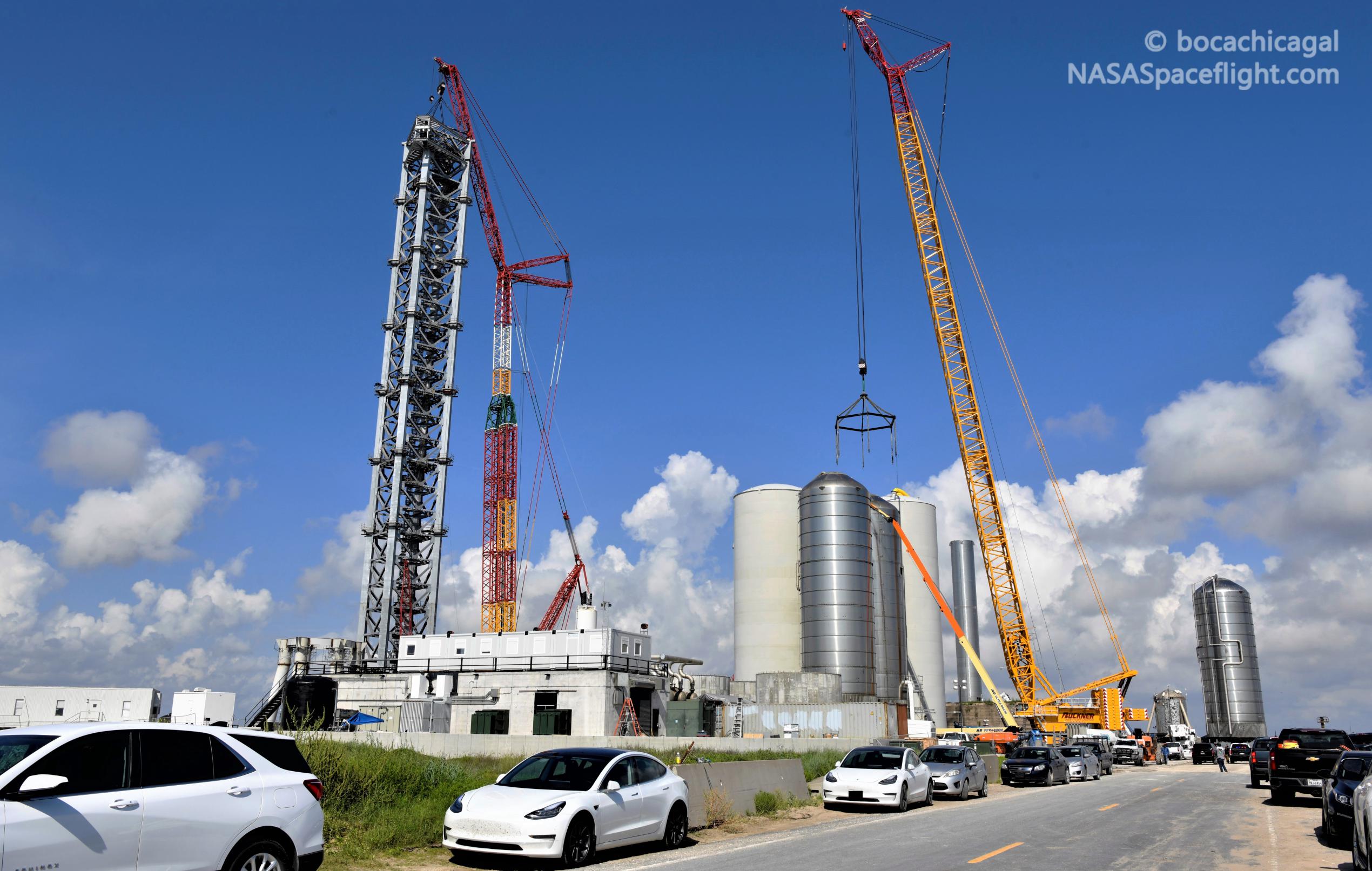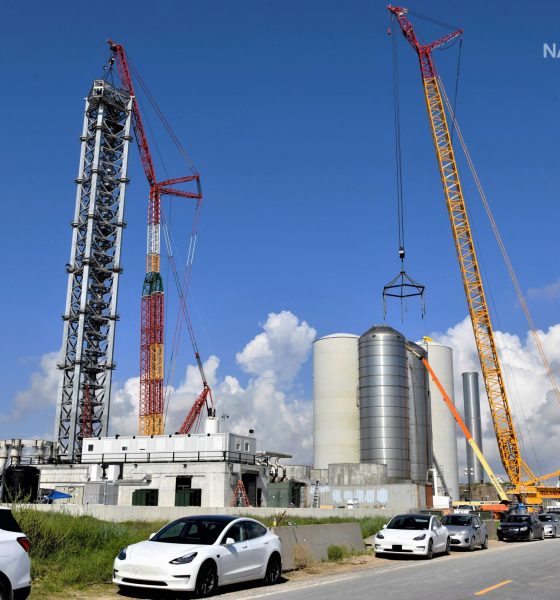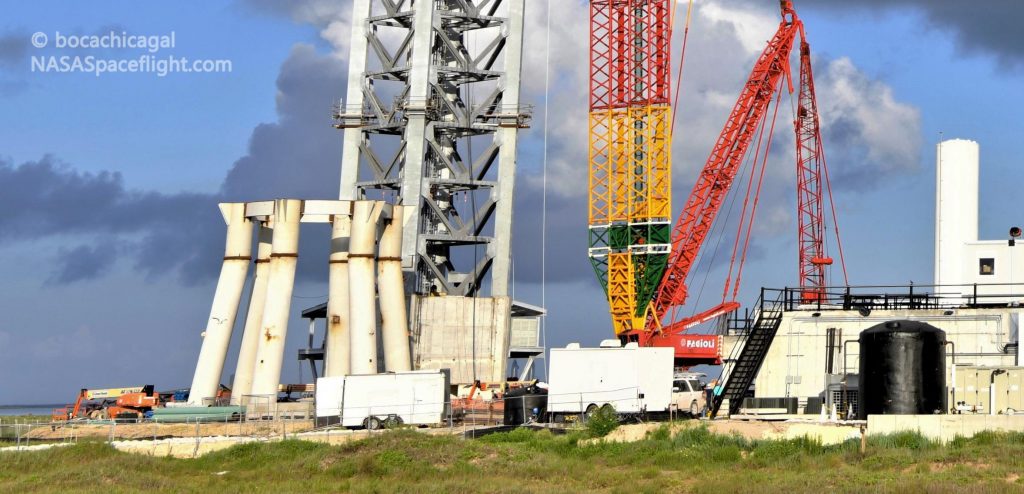

News
SpaceX shifts South Texas focus to Starship’s orbital launch pad
Highlighted by a Wednesday jam-packed with important milestones, SpaceX appears to be shifting its focus in South Texas to the completion of Starship’s first orbital launch pad.
Boca Chica will be the first time in its history that SpaceX has faced the challenge of (or had the opportunity to) build an orbital launch complex from scratch after gaining a great deal of expertise modifying, reactivating, and rebuilding two existing pads in Florida and one in California. SpaceX’s Boca Chica facilities must also support what will be the most powerful rocket ever built (or tested) and a planned flight rate and turnaround capability that drastically exceeds anything the company (or anyone else, really) has attempted.
As a result, the site looks almost nothing like SpaceX’s other launch facilities. On top of the already significant hurdles faced, SpaceX is also attempting to complete its from-scratch facility in record time and work on Starship’s orbital launch site (OLS) really only began in earnest around the start of 2021. That aggressive work schedule has begun to clearly bear fruit in the last few months and arguably reached a bit of a local peak on Wednesday, July 28th.
A Tower Is Born
Kicking off the day after an aborted attempt on Tuesday, SpaceX began what would turn out to be an extremely busy Wednesday around 5am CDT (UTC-5) with the installation of the Starship launch tower’s ninth and final prefabricated section, effectively completing the structure’s skeleton. Unlike all other SpaceX pads, save for Pad 39A’s single-purpose Dragon and Crew Access Arm, Starship’s first orbital launch pad will lean heavily on a massive steel tower.
By all appearances, Starship’s launch tower will host an elevator-like carriage outfitted with several large arms on its exterior and will use those arms to stabilize, stack, fuel, and maybe even catch Starships and Super Heavy boosters. The tower will be integral to routine Starship launch operations, in other words.
With the installation of one last steel segment, that tower grew to a height of ~145m (~440 ft) and isn’t expected to get any taller after a 10m/30ft lightning rod is eventually added. SpaceX’s pad team can now begin the process of finalizing tower construction, ranging from adding cladding on its rectangular exterior and welding all nine steel sections together to filling its four legs with concrete.
Tank and Table
Just a few hours after the start of Tower Section #9 installation, a fleet of SpaceX’s self-propelled modular transporters (SPMTs) left the build site with two major pieces of orbital pad hardware in tow. For the first time in three months, one of those payloads was an OLS propellant storage tank built by SpaceX itself out of parts almost identical to those found on Starship. Since the first two ground support equipment (GSE) tanks were rapidly installed in April, activity on that front has been curiously stagnant.
Since modifications of those tanks began in-situ over the last month or so, the general consensus has been that a fairly minor design flaw or oversight was discovered well after production began, requiring a significant pause to rework and redesign the crucial pad components. In the meantime, work on contractor-built GSE tank shells meant to eventually insulate SpaceX’s thin cryogenic storage tanks continued unabated and one water tank and six shells have already been more or less completed. With any luck, GSE tank #5’s delivery to the OLS means that SpaceX has removed the roadblock(s) and is ready to move into plumbing and tank farm activation.
Simultaneously, a far more significant part known as the Starship ‘launch table’ also left SpaceX’s Boca Chica build site after nearly six months of around-the-clock assembly and outfitting. Designed to secure, fuel, and launch orbital Starships, the launch table has to be able to withstand the ~5000 metric ton (~11 million lb) weight of a fully-fueled Starship, hold Super Heavy in place during static fires and prelaunch ignitions that could produce ~7500 metric tons of thrust, and survive the unspeakable fury of 33 Raptor engines operating simultaneously.
Unlike all other major orbital Starship launch pad parts, the custom launch mount and table’s successful and near-total completion is an absolute necessity for any kind of orbital test flight or full-up Super Heavy static fire. Only part of the tank farm is truly necessary and the vast majority of the tower’s intended tasks can be completed with workarounds if neither are fully ready. Without the launch mount, however, testing much beyond what SpaceX has already accomplished is mostly impossible in the near term.

Raptor Invasion
Finally, while less pressing, SpaceX also accepted delivery of four Raptor engines on top of three more that were delivered to Boca Chica on Tuesday. According to CEO Elon Musk, Starship’s first orbital test flight(s) will happen with a full complement of engines installed, meaning that SpaceX will need to build, qualify, and ship at least 35 new Raptors for a single flight.
SpaceX recently completed assembly of the 100th full-scale Raptor engine at its Hawthorne factory and HQ – an encouraging sign that the engines needed for Starship’s orbital launch debut will be ready for flight sooner than later.

News
Tesla FSD fleet is nearing 7 billion total miles, including 2.5 billion city miles
As can be seen on Tesla’s official FSD webpage, vehicles equipped with the system have now navigated over 6.99 billion miles.

Tesla’s Full Self-Driving (Supervised) fleet is closing in on almost 7 billion total miles driven, as per data posted by the company on its official FSD webpage.
These figures hint at the massive scale of data fueling Tesla’s rapid FSD improvements, which have been quite notable as of late.
FSD mileage milestones
As can be seen on Tesla’s official FSD webpage, vehicles equipped with the system have now navigated over 6.99 billion miles. Tesla owner and avid FSD tester Whole Mars Catalog also shared a screenshot indicating that from the nearly 7 billion miles traveled by the FSD fleet, more than 2.5 billion miles were driven inside cities.
City miles are particularly valuable for complex urban scenarios like unprotected turns, pedestrian interactions, and traffic lights. This is also the difference-maker for FSD, as only complex solutions, such as Waymo’s self-driving taxis, operate similarly on inner-city streets. And even then, incidents such as the San Francisco blackouts have proven challenging for sensor-rich vehicles like Waymos.
Tesla’s data edge
Tesla has a number of advantages in the autonomous vehicle sector, one of which is the size of its fleet and the number of vehicles training FSD on real-world roads. Tesla’s nearly 7 billion FSD miles then allow the company to roll out updates that make its vehicles behave like they are being driven by experienced drivers, even if they are operating on their own.
So notable are Tesla’s improvements to FSD that NVIDIA Director of Robotics Jim Fan, after experiencing FSD v14, noted that the system is the first AI that passes what he described as a “Physical Turing Test.”
“Despite knowing exactly how robot learning works, I still find it magical watching the steering wheel turn by itself. First it feels surreal, next it becomes routine. Then, like the smartphone, taking it away actively hurts. This is how humanity gets rewired and glued to god-like technologies,” Fan wrote in a post on X.
News
Tesla starts showing how FSD will change lives in Europe
Local officials tested the system on narrow country roads and were impressed by FSD’s smooth, human-like driving, with some calling the service a game-changer for everyday life in areas that are far from urban centers.

Tesla has launched Europe’s first public shuttle service using Full Self-Driving (Supervised) in the rural Eifelkreis Bitburg-Prüm region of Germany, demonstrating how the technology can restore independence and mobility for people who struggle with limited transport options.
Local officials tested the system on narrow country roads and were impressed by FSD’s smooth, human-like driving, with some calling the service a game-changer for everyday life in areas that are far from urban centers.
Officials see real impact on rural residents
Arzfeld Mayor Johannes Kuhl and District Administrator Andreas Kruppert personally tested the Tesla shuttle service. This allowed them to see just how well FSD navigated winding lanes and rural roads confidently. Kruppert said, “Autonomous driving sounds like science fiction to many, but we simply see here that it works totally well in rural regions too.” Kuhl, for his part, also noted that FSD “feels like a very experienced driver.”
The pilot complements the area’s “Citizen Bus” program, which provides on-demand rides for elderly residents who can no longer drive themselves. Tesla Europe shared a video of a demonstration of the service, highlighting how FSD gives people their freedom back, even in places where public transport is not as prevalent.
What the Ministry for Economic Affairs and Transport says
Rhineland-Palatinate’s Minister Daniela Schmitt supported the project, praising the collaboration that made this “first of its kind in Europe” possible. As per the ministry, the rural rollout for the service shows FSD’s potential beyond major cities, and it delivers tangible benefits like grocery runs, doctor visits, and social connections for isolated residents.
“Reliable and flexible mobility is especially vital in rural areas. With the launch of a shuttle service using self-driving vehicles (FSD supervised) by Tesla in the Eifelkreis Bitburg-Prüm, an innovative pilot project is now getting underway that complements local community bus services. It is the first project of its kind in Europe.
“The result is a real gain for rural mobility: greater accessibility, more flexibility and tangible benefits for everyday life. A strong signal for innovation, cooperation and future-oriented mobility beyond urban centers,” the ministry wrote in a LinkedIn post.
News
Tesla China quietly posts Robotaxi-related job listing
Tesla China is currently seeking a Low Voltage Electrical Engineer to work on circuit board design for the company’s autonomous vehicles.

Tesla has posted a new job listing in Shanghai explicitly tied to its Robotaxi program, fueling speculation that the company is preparing to launch its dedicated autonomous ride-hailing service in China.
As noted in the listing, Tesla China is currently seeking a Low Voltage Electrical Engineer to work on circuit board design for the company’s autonomous vehicles.
Robotaxi-specific role
The listing, which was shared on social media platform X by industry watcher @tslaming, suggested that Tesla China is looking to fill the role urgently. The job listing itself specifically mentions that the person hired for the role will be working on the Low Voltage Hardware team, which would design the circuit boards that would serve as the nervous system of the Robotaxi.
Key tasks for the role, as indicated in the job listing, include collaboration with PCB layout, firmware, mechanical, program management, and validation teams, among other responsibilities. The role is based in Shanghai.
China Robotaxi launch
China represents a massive potential market for robotaxis, with its dense urban centers and supportive policies in select cities. Tesla has limited permission to roll out FSD in the country, though despite this, its vehicles have been hailed as among the best in the market when it comes to autonomous features. So far, at least, it appears that China supports Tesla’s FSD and Robotaxi rollout.
This was hinted at in November, when Tesla brought the Cybercab to the 8th China International Import Expo (CIIE) in Shanghai, marking the first time that the autonomous two-seater was brought to the Asia-Pacific region. The vehicle, despite not having a release date in China, received a significant amount of interest among the event’s attendees.








